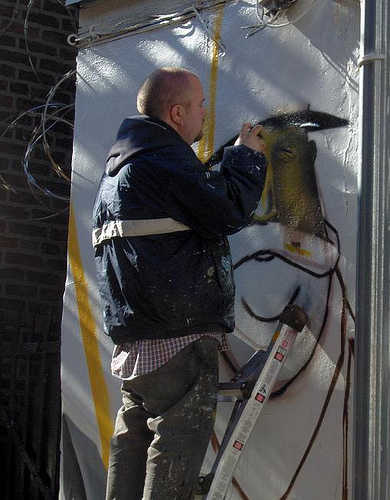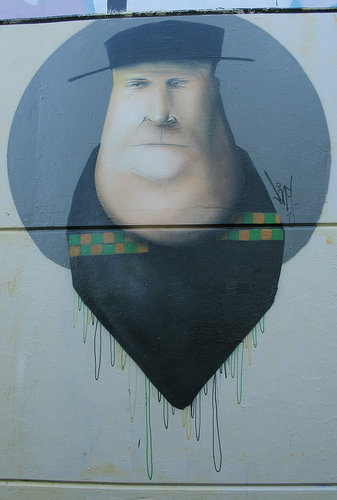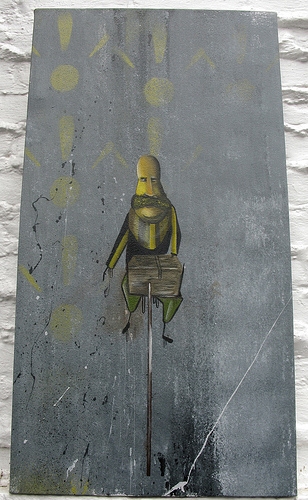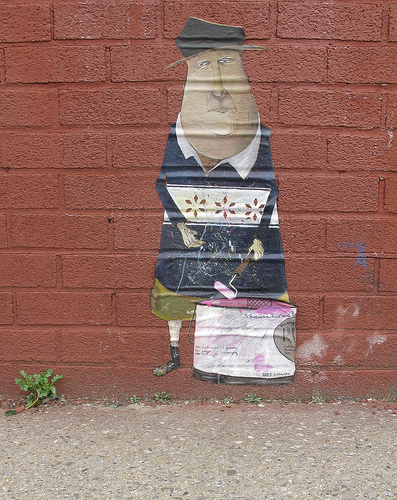Since Vandalog started 100-some days ago, I’ve mentioned Veng four times. Why is that? It’s not just because I have nothing to talk about. It’s because one, I wanted to feature him and his crew, Robots Will Kill; two, Andrew Michael Ford from Ad Hoc Art mentioned them as well when he spoke about great street artists in NYC; three, Veng knows New York graffiti and street art, so he was part of my Great in ’08 series; and four, he was recently had some work in the From The Streets of Brooklyn exhibition at Thinkspace Art Gallery. But mostly, it’s because he’d good at what he does.
Veng is one of those artists blurring the line between street art and graffiti. I’ve been looking forward to this interview for a while. I think Veng is one of the most important artists to be watching in 2009, and I had to make sure Vandalog readers get to know him. Sorry if I sound like a bit over-enthusiastic, but it’s rare to find an artist of such talent who is not very well known outside of his home town.
I would try to describe Veng’s work, but he does a much better job, so I’ll just get to the Q&A.
RJ: How long have you been painting, graffiti/street art or otherwise?
Veng: I have been painting and drawing since I was little kid, and got into graffiti around the age of 12.
RJ: Why do you paint on the street?
Veng: For me painting on the street is in the excitement that each time you go out it’s different from the last time. The people you can meet while out painting or pasting can give you opportunities for stories I normally never would have had if all my time was just spent traditionally in a studio. Also the architecture of a city and how it gives you countless surfaces to place your work within is also a draw.
RJ: What do you think it is about New York City that attracts so many graffiti writers and street artists?
Veng: NYC has a vibe of being very raw which I feel attracts these two art forms to a large degree. Graffiti was for the most part started here in the Bronx, so for the graff artist it is a pilgrimage to paint in the city that made it famous and to view works from the guys who were around back then. As for street art I think the close knit community here in NY is a reason a lot come, plus having some great artists who kicked it into high gear like Swoon, Dan Witz,Revs, Elbow-Toe etc. I feel it also has to do with the fact that NYC streets are not the cleanest and have some great old buildings and all sorts of nooks and crannies that an artist can work with. It is just a great place to be.
RJ: In moving from a sort of abstract graffiti style to painting a wide characters, do you feel like you’ve moved from graffiti to street art?
Veng: I feel I am moving in a direction towards street art more these days, The working process is what attracts me most, I can work with oil paint on paper or panel and use traditional techniques as a painter, but then put it on the street with a space that fits that piece, not just a hall of fame or legal spot. The possibility of size though is what I enjoy with graffiti, as I can go much larger then with a poster or board. In graffiti what I enjoy most is still the working with fellow friends on a wall painting it as one.
Is there a difference in your mind? I think the difference lies more with the people then the scenes themselves. The street art scene is filled with more people into traditional art and has approached their work on the streets with this prior knowledge. In graffiti it seems kids start off learning about graffiti then getting into other forms of art.
RJ: I hear that your characters look a lot like self-portraits, is this true?
Veng: This was not my intention when starting with these guys. lol. To a degree it is I guess, although I think they have a likeness in resemblance to my father more than me.
RJ: How do you develop an image for a mural or canvas? Do you just get out a sketchbook and draw whatever comes, or does it start with an idea and go from there?
Veng: Almost all of the time whether on walls or canvas it is from something I have seen, I then will take that basic idea to my book and try to think of a way to change the reality of it by combining it with something not typically used with it. My intention is to create an image that has all the qualities of being lifelike due to how I paint in a semi-realistic manner with things people relate to, but making sure the fantasy of it is still there.
RJ: What other artists have influenced your work?
Veng: In a short list Jan Van Eyck, Hans Memling, Gerard David,Petrus Christus, Rembrandt, John Haberle, Chuck Close, fellow street and graff artists, Ecb, Loomit, Flying Fortress, rwk, elbow toe, Solovei, Swoon, Cake, Becki Fuller and all of nature.
RJ: Each member of Robots Will Kill has a very distinctive style, how did you realize that all of these different styles meshed together as they do? Other than the occasional duo like Herakut, it seems rare for artists with such different styles work so closely with one another.
Veng: It just happened after all the years of practicing, painting, arguing, experimenting.
RJ: What do you do besides your artwork?
Veng: Just the normal activities of anyone, see friends, watch TV. Read.
RJ: Where would you like to get up, but haven’t had the chance yet?
Veng: I have been to some European countries and will continue to go as long as I can travel, but as far as special places I would love to work in India and Morocco. The atmosphere of those two places I feel would be unreal to witness and the architecture would produce some wonderful photos for the backdrop. The energy in people, food and dress I imagine would be pure creative heaven.
RJ: What’s next for you?
Veng: Lots of work on paper for the streets, I have a show coming up at the Carmichael Gallery in L.A., some group shows here in New York and in Belgium. To continue to also have loads of fun creating art and meeting new people along the way!
Photos from Veng’s flickr






